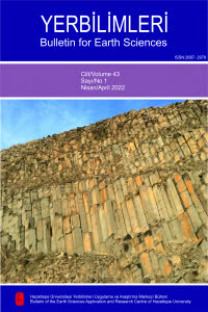Kusuri formasyonu'nun fasiyes toplulukları (Batı Pontidler; Paleojen,Türkiye)
Pontidler'in batısında yer alan Geç Paleösen-Eosen yaşlı Kusuri formasyonunu oluşturan epiklastik ve volkaniklastik birimler sedimantolojik özellikleri bakımından dört fasiyes altında toplanırlar. Geç Paleosen-Erken Eosen yaşlı türbidit kumtaşı fasiyesi (F1) Kusuri formasyonunun en alt fasiyesini oluşturmaktadır. Kumtaşı-şeyl arkalanmasından oluşan ve denizaltı yelpazesinin orta-dış yelpaze fasiyeslerinin tipik özelliklerini taşıyan türbidit kumtaşı fasiyesi Geç Paleosen öncesi yaşlı birimlerle parakonformite sınır ilişkisine sahiptir. Bu fasiyesin derin deniz türbidit çökelleri üzerine andezitik litik tüf ve tüf-breşi ile volkaniklastik kumtaşı-silttaşından oluşan volkaniklastik fasiyes (F2) gelmektedir. Kusuri formasyonu içinde tanımlanan üçüncü fasiyesi piroklastik fasiyes (F3) oluşturmaktadır. Diğer fasiyeslere kıyasla kalınlığı az olan bu fasiyes patlamalı volkanizma ürünü olan küllerin oluşturduğu kristal ve vitrik tüflerle tanımlanmaktadır. Kusuri formasyonunda tanımlanan son fasiyes kumtaşı-kiltaşı ardalanmasından oluşan Orta Eosen yaşlı sığ deniz fasiyesidir. Geç Kretase'de Neotetis'in kuzeye Pontidler altına dalmasına bağlı olarak Pontidler üzerinde yığışım prizması ve yay volkanizmasının gelişimi inceleme alanını da içine alan bölgede sırtlaşan yayönü havzasını oluşturmuştur. Geç Paleosen'den itibaren güneydeki yığışım prizmasından türbit akıntılarla havzaya malzeme taşınmış ve derin deniz ortamında türbidit kumtaşı fasiyesi çökelmiştir. Geç Kretase yay volkanizmasının daha sö'nra güneye kayarak Eosen'de, inceleme alanının güneyindeki yığışım prizması üzerinde gelişimi ile havza iki yay volkanizması arasında kalmıştır. Volkaniklastik, piroklastik ve sığ deniz fasiyeslerine ait kayaçlar bu yayarası havzada çökelmişlerdir. Volkaniklastik ve piroklastik fasiyesler Eosen yay volkanizmasından türeyen malzemelerle oluşmuş, sığ deniz kumtaşı fasiyesi ise Lütesiyen öncesinde yüzeyleyen tüm birimlerden malzeme almıştır.
Facies associations of Kusuri formation (Western Pontides;Paleogene Turkey)
Epiclastic and volcaniclastic units which form the Kusuri formation with the age of Late Paleocene-Eocene located in the western Pontides can be divided into four facies according to sedimentological characteristics. Turbidite sandstone facies (F1) with the age of Late Paleocene-Early Eocene forms the bottom facies of the Kusuri formation. The turbidite sandstone facies that consists of sandstone-shale alternations and has typical characteristics of middle-outer fan facies of submarine fan, has a paraconformite contact relationship with the units of pre-Late Paleocene age. The deep marine turbidite deposits of this facies are overlied by volcaniclastic facies (F2) which consists of lithic tuff and tuff breccia with andesitic composition and volcaniclastic sandstone-siltstone. The pyroclastic fades (F3) is the third facies of the Kusuri formation. This facies that is thinner than the other facies is characterized by crystal and vitric tuff which composed of ashes that are product of explosive volcanism. The last facies of Kusuri formation is a shallow marine fades of middle Eocene age that consists of sandstone-claystone alternation. Depending on the descent of Neotetis in the northern direction beneath Pontides in Late Cretaceous, accretionary prism and arc volcanism were developed on Pontides. This development brought about ridged forearc basin in the region which covers the study area. Starting from late Paleocene, turbidite sandstone facies is deposited in deep sea environment as a result of material transfer by turbidity currents from accretionary prism to the south of the study area to the basin. In Eocene, the activity of Late Cretaceous arc volcanism on the accretionary prism to the southern of the study area is caused to the basin to be located between these two arc volcanism. The rocks which belong to volcaniclastic, pyroclastic and shallow marine sandstone facies are deposited in the basin between these two arcs. Volcaniclastic and pyroclastic facies are composed of materials coming from Eocene arc volcanism while shallow marine sandstone facies has material from all the units outcroped before Lutetian.
